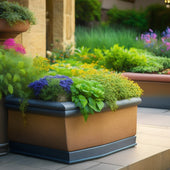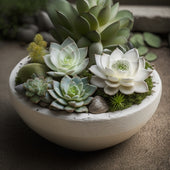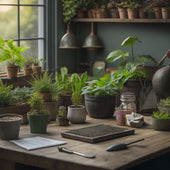
5 Essential Tips for Succulent Rooftop Garden Design
Share
When designing a succulent rooftop garden, you'll want to choose species that thrive in high sunlight, like Aloe and Echeveria, and consider compact growth habits for aesthetic appeal. Assess your rooftop's climate, taking note of sun exposure, wind patterns, and temperature fluctuations to select suitable species and guarantee proper watering. Select a well-draining growing medium, and balance aesthetics and functionality by incorporating seating, lighting, and focal points. Finally, prioritize proper drainage and maintenance, establishing a watering schedule and regularly inspecting plants. By considering these essential tips, you'll be well on your way to creating a stunning and resilient rooftop oasis that awaits further exploration.
Choose the Right Succulent Species
When designing a thriving rooftop succulent garden, selecting species that can withstand extreme temperatures, direct sunlight, and windy conditions is crucial. Since rooftops receive intense sunlight, you should choose succulents with high sunlight requirements, like Aloe, Echeveria, and Crassula. These species will flourish in full sun to partial shade, and their compact growth habits will create an aesthetically pleasing arrangement.
For succulent care, understanding drought tolerance is vital. Succulents such as Sedum, Sempervivum, and Kalanchoe have evolved to store water in their leaves, stems, or roots, making them well-suited for rooftop gardens. This characteristic enables them to thrive with infrequent watering, making them low-maintenance and ideal for busy gardeners.
Nevertheless, regular watering is still necessary, but with reduced frequency. Try to water your succulents every 7-10 days in hot summer months and every 4-6 weeks during cooler seasons. By selecting the appropriate species and grasping their specific requirements, you'll be on your way to crafting a remarkable and resilient rooftop succulent garden.
Consider Rooftop Climate Conditions
You'll need to factor in the unique climate conditions of your rooftop, where intense sunlight, high winds, and extreme temperatures can impact your succulent garden's performance. To guarantee your plants thrive, consider the following climate factors:
-
Sun exposure: Assess the amount of direct sunlight your rooftop receives, and choose succulent species that can tolerate high temperatures and intense light.
-
Wind patterns: Take note of the wind direction and speed to prevent soil erosion and plant damage.
-
Temperature fluctuations: Be mindful of extreme temperature changes and how they may affect your plants' water needs and growth.
-
Insulation and waterproofing: Make sure your rooftop garden has adequate insulation to regulate soil temperature and prevent waterlogging.
-
Microclimates: Identify any microclimates on your rooftop, such as areas with shade or unique wind patterns, to create a diverse and thriving succulent garden.
Select a Suitable Growing Medium
For your rooftop succulent garden, a well-draining growing medium is essential to prevent waterlogged soil and root rot, so choose a mix specifically designed for cacti and succulents that contains a blend of perlite, vermiculite, and sand. This soil composition allows for best water penetration and aeration, reducing the risk of overwatering.
When selecting a growing medium, consider the watering frequency you plan to maintain. If you tend to forget to water, opt for a mix with higher water-retentive properties. On the other hand, if you prefer to water infrequently, choose a mix that drains quickly.
Container size also plays an important role in your rooftop succulent garden. Ensure the container is large enough to accommodate the mature size of your plants, taking into account sunlight exposure. If your rooftop receives full sun, choose a container that provides adequate root space to prevent overheating. Conversely, if your rooftop receives partial shade, a smaller container may suffice.
Balance Aesthetics and Functionality
With your rooftop succulent garden's foundation in place, it's time to balance aesthetics and functionality by thoughtfully arranging plants, containers, and hardscapes to create a visually stunning yet highly functional outdoor space.
This is where your design skills come into play, as you need to create a harmonious blend of form and function.
To achieve this balance, consider the following key elements:
-
Incorporating seating: Add benches, chairs, or even a daybed to create cozy nooks for relaxation and enjoyment.
-
Adding lighting: String lights, lanterns, or pathway lights can enhance the ambiance and highlight your succulent arrangements.
-
Creating a focal point: Use a statement piece, like a large planter or a sculpture, to draw the eye and create visual interest.
-
Incorporating texture: Mix different materials, such as wood, metal, and stone, to add depth and variety to your design.
-
Defining zones: Divide your rooftop space into different areas, like a seating area, a planting zone, and a walkway, to create a sense of flow and functionality.
Ensure Proper Drainage and Maintenance
As you bring your rooftop succulent garden to life, prioritizing proper drainage and maintenance is essential for preventing waterlogged soil and maintaining the long-term health of your plants. A well-designed drainage system ensures excess water doesn't accumulate, reducing the risk of root rot and other issues. Make sure your planters have built-in drainage holes or add a layer of perlite or vermiculite to improve soil aeration.
Develop a watering schedule tailored to your rooftop's unique conditions, taking into account sunlight access, temperature, and humidity. Overwatering is a common mistake, so start with infrequent watering and adjust as needed.
Regular maintenance is also key, involving tasks like pruning, fertilizing, and repotting. Set aside time each week to inspect your plants, removing any dead or damaged leaves to prevent the spread of disease.
Frequently Asked Questions
Can I Use a Pre-Made Succulent Arrangement on My Rooftop Garden?
You can use a pre-made succulent arrangement on your rooftop, but consider the container's material, drainage, and weight capacity for rooftop gardening. Alternatively, create your own DIY arrangements to guarantee a perfect fit for your space.
How Do I Protect My Rooftop Garden From Strong Winds?
You'll need to shield your rooftop garden from gusty winds by installing wind barriers, like trellises or screens, and anchoring plants with sturdy stems or weighing down pots to prevent toppling and damage.
Are There Any Rooftop Garden Design Ideas for Small Spaces?
You'll be surprised to know that 75% of urban dwellers crave green spaces! For small rooftop gardens, you'll love using vertical planters and succulent pots to maximize space, while hanging succulents and compact designs add visual appeal.
Can I Integrate Solar Panels Into My Rooftop Succulent Garden?
You can definitely integrate solar panels into your rooftop succulent garden, balancing sustainable energy with garden aesthetics. Strategically place panels around plants, ensuring ideal sun exposure for both energy harvesting and healthy plant growth.
Do I Need a Permit to Create a Rooftop Succulent Garden?
You'll likely need a permit for your rooftop succulent garden, as local authorities will assess your design for compliance with drainage requirements and height restrictions, ensuring a structurally sound and safe installation.
Related Posts
-

5 Essential Drainage Tips for Block Planters
When using block planters, you'll want to guarantee effective drainage to prevent waterlogging and root rot. Start by...
-

5 Essential Drainage Tips for Block Planters
When using block planters, you'll want to guarantee effective drainage to prevent waterlogging and root rot. Start by...
-

5 Essential Drainage Tips for Block Planters
When using block planters, you'll want to guarantee effective drainage to prevent waterlogging and root rot. Start by...
-

5 Essential Drainage Tips for Block Planters
When using block planters, you'll want to guarantee effective drainage to prevent waterlogging and root rot. Start by...
-

5 Essential Drainage Tips for Block Planters
When using block planters, you'll want to guarantee effective drainage to prevent waterlogging and root rot. Start by...
-

5 Essential Drainage Tips for Block Planters
When using block planters, you'll want to guarantee effective drainage to prevent waterlogging and root rot. Start by...
-

5 Essential Drainage Tips for Block Planters
When using block planters, you'll want to guarantee effective drainage to prevent waterlogging and root rot. Start by...
-

5 Essential Drainage Tips for Block Planters
When using block planters, you'll want to guarantee effective drainage to prevent waterlogging and root rot. Start by...
-

5 Essential Drainage Tips for Block Planters
When using block planters, you'll want to guarantee effective drainage to prevent waterlogging and root rot. Start by...
-

5 Essential Drainage Tips for Block Planters
When using block planters, you'll want to guarantee effective drainage to prevent waterlogging and root rot. Start by...
-

5 Essential Drainage Tips for Block Planters
When using block planters, you'll want to guarantee effective drainage to prevent waterlogging and root rot. Start by...
-

5 Essential Drainage Tips for Block Planters
When using block planters, you'll want to guarantee effective drainage to prevent waterlogging and root rot. Start by...
-

5 Essential Drainage Tips for Block Planters
When using block planters, you'll want to guarantee effective drainage to prevent waterlogging and root rot. Start by...
-

5 Essential Drainage Tips for Block Planters
When using block planters, you'll want to guarantee effective drainage to prevent waterlogging and root rot. Start by...
-

5 Essential Drainage Tips for Block Planters
When using block planters, you'll want to guarantee effective drainage to prevent waterlogging and root rot. Start by...
-

5 Essential Drainage Tips for Block Planters
When using block planters, you'll want to guarantee effective drainage to prevent waterlogging and root rot. Start by...
-

5 Essential Drainage Tips for Block Planters
When using block planters, you'll want to guarantee effective drainage to prevent waterlogging and root rot. Start by...
-

5 Essential Drainage Tips for Block Planters
When using block planters, you'll want to guarantee effective drainage to prevent waterlogging and root rot. Start by...
-

What Makes a Great Planter for Succulents
When selecting a great planter for succulents, you'll want to take into account a combination of factors to guarantee...
-

What Makes a Great Planter for Succulents
When selecting a great planter for succulents, you'll want to take into account a combination of factors to guarantee...
-

What Makes a Great Planter for Succulents
When selecting a great planter for succulents, you'll want to take into account a combination of factors to guarantee...
-

What Makes a Great Planter for Succulents
When selecting a great planter for succulents, you'll want to take into account a combination of factors to guarantee...
-

What Makes a Great Planter for Succulents
When selecting a great planter for succulents, you'll want to take into account a combination of factors to guarantee...
-

What Makes a Great Planter for Succulents
When selecting a great planter for succulents, you'll want to take into account a combination of factors to guarantee...
-

What Makes a Great Planter for Succulents
When selecting a great planter for succulents, you'll want to take into account a combination of factors to guarantee...
-

What Makes a Great Planter for Succulents
When selecting a great planter for succulents, you'll want to take into account a combination of factors to guarantee...
-

What Makes a Great Planter for Succulents
When selecting a great planter for succulents, you'll want to take into account a combination of factors to guarantee...
-

What Makes a Great Planter for Succulents
When selecting a great planter for succulents, you'll want to take into account a combination of factors to guarantee...
-

What Makes a Great Planter for Succulents
When selecting a great planter for succulents, you'll want to take into account a combination of factors to guarantee...
-

What Makes a Great Planter for Succulents
When selecting a great planter for succulents, you'll want to take into account a combination of factors to guarantee...
-

What Makes a Great Planter for Succulents
When selecting a great planter for succulents, you'll want to take into account a combination of factors to guarantee...
-

What Makes a Great Planter for Succulents
When selecting a great planter for succulents, you'll want to take into account a combination of factors to guarantee...
-

What Makes a Great Planter for Succulents
When selecting a great planter for succulents, you'll want to take into account a combination of factors to guarantee...
-

What Makes a Great Planter for Succulents
When selecting a great planter for succulents, you'll want to take into account a combination of factors to guarantee...
-

What Makes a Great Planter for Succulents
When selecting a great planter for succulents, you'll want to take into account a combination of factors to guarantee...
-

What Makes a Great Planter for Succulents
When selecting a great planter for succulents, you'll want to take into account a combination of factors to guarantee...
-

What Makes a Great Planter for Succulents
When selecting a great planter for succulents, you'll want to take into account a combination of factors to guarantee...
-

What Makes a Great Planter for Succulents
When selecting a great planter for succulents, you'll want to take into account a combination of factors to guarantee...
-

What Makes a Great Planter for Succulents
When selecting a great planter for succulents, you'll want to take into account a combination of factors to guarantee...
-

What Makes a Great Planter for Succulents
When selecting a great planter for succulents, you'll want to take into account a combination of factors to guarantee...
-

What Makes a Great Planter for Succulents
When selecting a great planter for succulents, you'll want to take into account a combination of factors to guarantee...
-

What Makes a Great Planter for Succulents
When selecting a great planter for succulents, you'll want to take into account a combination of factors to guarantee...
-

Why Invest in Specialized Planter Tools
You'll greatly boost your gardening success and yields by leveraging specialized planter tools that cater to the uniq...
-

Why Invest in Specialized Planter Tools
You'll greatly boost your gardening success and yields by leveraging specialized planter tools that cater to the uniq...
-

Why Invest in Specialized Planter Tools
You'll greatly boost your gardening success and yields by leveraging specialized planter tools that cater to the uniq...
-

Why Invest in Specialized Planter Tools
You'll greatly boost your gardening success and yields by leveraging specialized planter tools that cater to the uniq...
-

Why Invest in Specialized Planter Tools
You'll greatly boost your gardening success and yields by leveraging specialized planter tools that cater to the uniq...
-

Why Invest in Specialized Planter Tools
You'll greatly boost your gardening success and yields by leveraging specialized planter tools that cater to the uniq...
-

Why Invest in Specialized Planter Tools
You'll greatly boost your gardening success and yields by leveraging specialized planter tools that cater to the uniq...
-

Why Invest in Specialized Planter Tools
You'll greatly boost your gardening success and yields by leveraging specialized planter tools that cater to the uniq...
-

Why Invest in Specialized Planter Tools
You'll greatly boost your gardening success and yields by leveraging specialized planter tools that cater to the uniq...
-

Why Invest in Specialized Planter Tools
You'll greatly boost your gardening success and yields by leveraging specialized planter tools that cater to the uniq...
-

Why Invest in Specialized Planter Tools
You'll greatly boost your gardening success and yields by leveraging specialized planter tools that cater to the uniq...
-

Why Invest in Specialized Planter Tools
You'll greatly boost your gardening success and yields by leveraging specialized planter tools that cater to the uniq...
-

Why Invest in Specialized Planter Tools
You'll greatly boost your gardening success and yields by leveraging specialized planter tools that cater to the uniq...
-

Why Invest in Specialized Planter Tools
You'll greatly boost your gardening success and yields by leveraging specialized planter tools that cater to the uniq...
-

Why Invest in Specialized Planter Tools
You'll greatly boost your gardening success and yields by leveraging specialized planter tools that cater to the uniq...
-

Why Invest in Specialized Planter Tools
You'll greatly boost your gardening success and yields by leveraging specialized planter tools that cater to the uniq...
-

Why Invest in Specialized Planter Tools
You'll greatly boost your gardening success and yields by leveraging specialized planter tools that cater to the uniq...
-

Why Invest in Specialized Planter Tools
You'll greatly boost your gardening success and yields by leveraging specialized planter tools that cater to the uniq...
-

Why Invest in Specialized Planter Tools
You'll greatly boost your gardening success and yields by leveraging specialized planter tools that cater to the uniq...
-

Why Invest in Specialized Planter Tools
You'll greatly boost your gardening success and yields by leveraging specialized planter tools that cater to the uniq...
-

Why Invest in Specialized Planter Tools
You'll greatly boost your gardening success and yields by leveraging specialized planter tools that cater to the uniq...
-

Why Invest in Specialized Planter Tools
You'll greatly boost your gardening success and yields by leveraging specialized planter tools that cater to the uniq...
-

Why Invest in Specialized Planter Tools
You'll greatly boost your gardening success and yields by leveraging specialized planter tools that cater to the uniq...
-

Why Invest in Specialized Planter Tools
You'll greatly boost your gardening success and yields by leveraging specialized planter tools that cater to the uniq...
-

Why Invest in Specialized Planter Tools
You'll greatly boost your gardening success and yields by leveraging specialized planter tools that cater to the uniq...


